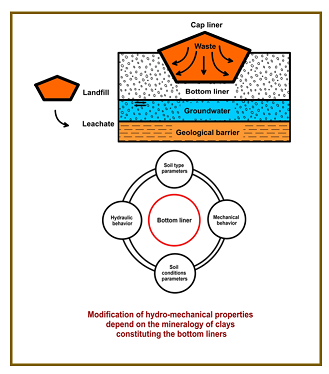Document Type : ORIGINAL RESEARCH ARTICLE
Authors
1 Laboratoire de Physique et de Chimie de l’Environnement, Université Joseph KI-Zerbo, BP 7021 Ouagadougou 03, Burkina Faso
2 Ecole Supérieure d’Ingénierie, Université de Fada N’Gourma, BP 46 Fada N’Gourma, Burkina Faso
3 Building Architecture and Town Planning Department, Université Libre de Bruxelles, Avenue F.D. Roosevelt 50, CP 194/2, 1050 Bruxelles, Belgique
4 Ecole Polytechnique de Ouagadougou, 08 BP 143 Ouagadougou 08, Burkina Faso
5 UMR 6294 CNRS, Laboratoire Ondes et Milieux Complexes, Normandie Université, Unihavre, 53 rue Prony, 76600 Le Havre, France
Abstract
BACKGROUND AND OBJECTIVES
In landfills, containment is provided by natural or artificial clayey materials known for their low permeability and for their pollutant retention capacity. However, the properties of these media are modified by leachates, whose migration they are supposed to limit. This study aims to reconsider the criteria for choosing suitable materials to make a bottom liner through both their long term hydraulic and mechanical performances.
METHODS
Two fine materials sampled in Burkina Faso (West Africa) have been characterized in order to compare their hydro-mechanical behavior in the presence of household waste leachates. The first material is classified as an inorganic clay of low to medium plasticity according to Casagrande plasticity diagram, it is mainly kaolinitic with some traces amounts of smectites. The second one is classified clayey sand of low to medium plasticity, the predominant mineral clay being kaolinite. Hydro-mechanical tests were performed on both sampled materials to judge the sealing properties of these materials, as well as the characteristics of deformation and rupture which have an important effect to ensure the durability of a bottom liner. All these tests were performed first with distilled water then with leachates as interstitial fluids in order to understand the modification of the hydro-mechanical properties of the clayey soils.
FINDINGS
Leachate contamination always alters hydraulic properties of the materials. However, between the two soils, the most clayey and the most impervious (soils from Nouna) undergo the deeper weathering. Indeed, hydraulic conductivity of these soils in contact with a synthetic leachate increases from 1.71x10-10 to 1.51x10-9 m/s. In contrast to soils from Boudry, these soils also undergo very significant settlements over the long term with compressibility indexes varying from 0.164 to 0.225. For both soils, the shear strength increases showing that, from this point view, the leachate work in the sense of of the bottom liner stability. For soils from Nouna, the effective cohesion increases from 3 to 21 kPa with a slight decrease of friction angle; for soils from Boudry a slight increase of cohesion is noticed while friction angle increases from 34 to 37°.
CONCLUSION
This comparative study is of practical use to environmental geotechnics professionals because it shows that the choice in designing a bottom liner must be a compromise between long term hydraulic and mechanical behaviors of soils. It is also important to know the nature of the flows to contain in order to ensure the durability of the structure.
Graphical Abstract
Highlights
- Hydro-mechanical tests show that if leachates are still harmful to the sealing of a bottom liner, it is not necessarily the case for its mechanical behavior;
- The criteria of choosing clays constituting bottom liners should be the result of a compromise between hydraulic and mechanical performance taking into account the composition of the leachate;
- Designing a bottom liner is a complex process that requires extensive investigations.
Keywords
Main Subjects
Open Access
©2022 The author(s). This article is licensed under a Creative Commons Attribution 4.0 International License, which permits use, sharing, adaptation, distribution and reproduction in any medium or format, as long as you give appropriate credit to the original author(s) and the source, provide a link to the Creative Commons license, and indicate if changes were made. The images or other third party material in this article are included in the article’s Creative Commons license, unless indicated otherwise in a credit line to the material. If material is not included in the article’s Creative Commons license and your intended use is not permitted by statutory regulation or exceeds the permitted use, you will need to obtain permission directly from the copyright holder. To view a copy of this license, visit: http://creativecommons.org/licenses/by/4.0/
Publisher’s Note
GJESM Publisher remains neutral concerning jurisdictional claims in published maps and institutional affiliations.
Citation Metrics & Captures
Google Scholar | Scopus | Web of Science | PlumX Metrics | Altmetrics | Mendeley |
Current Publisher
GJESM Publisher



Letters to Editor
[1] Letters that include statements of statistics, facts, research, or theories should include appropriate references, although more than three are discouraged.
[2] Letters that are personal attacks on an author rather than thoughtful criticism of the author’s ideas will not be considered for publication.
[3] Letters can be no more than 300 words in length.
[4] Letter writers should include a statement at the beginning of the letter stating that it is being submitted either for publication or not.
[5] Anonymous letters will not be considered.
[6] Letter writers must include their city and state of residence or work.
[7] Letters will be edited for clarity and length.
Send comment about this article